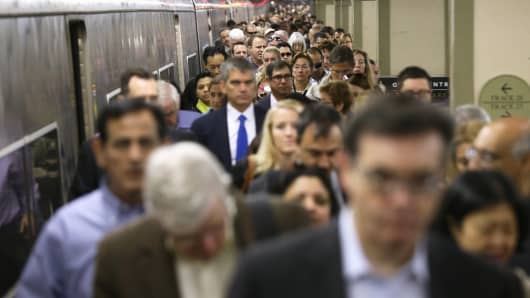Looking at just average hourly wages — adjusted for inflation using the Consumer Price Index (CPI) — shows that earnings increased only 5.58 percent since 1964. However, this statistic and others like it are misleading because they do not factor in new forms of growing employee compensation and they overstate the erosion of purchasing power. Once these contributions are taken into account, a much more clear — and positive — picture of the average incomes surfaces.
(Read more: Debunking the top three myths about income inequality)
Over the last few decades, employees have been receiving an increasingly larger portion of their overall compensation in the form of benefits such as health care, paid vacation time, hour flexibility, improved work environments and even daycare. Ignoring the growth of these benefits and looking at only wages provides a grossly incomplete picture of well-being, and the increase in compensation for work. While it is difficult to adjust for all of these benefits that workers are now receiving, one measure of wage and salary supplements show they have nearly tripled since 1964. Total compensation, which adds these benefits to wages and salaries, shows that earnings have actually increased more than 45 percent since 1964.
Furthermore, "purchasing power," the amount of stuff people can buy with each dollar, has changed dramatically over the last half decade and, surely, must be considered when evaluating the state of the average worker based on his or her take-home pay. CPI is notorious for overstating inflation, and thus understating the growth of real wages received by workers. Adjusting the data with the more appropriate Personal Consumption Expenditure index brings the growth in average hourly wages from 5.58 percent to more than 35 percent and the growth in total compensation of employees from more than 45 percent to more than 87 percent.
(Read more: Carol Roth: Why inequality isn't a problem)
But even that index fails to grasp the drastic increase in what workers get for their wages. According to the economist Mark Perry of the American Enterprise Institute (AEI), 100.5 hours of work was required to purchase a washing machine in 1959 compared to just 23.3 hours of work (for the average worker) in 2013. Purchasing a TV demanded an astounding 127.8 hours of work in 1959, whereas a worker in 2013 could purchase one with only 20.7 hours of work.
Moreover, the improved quality of these goods over the past few decades is staggering. The first cellphones were bulky, unaesthetic and provided poor cellular service. Today's iPhones and other smart-phone models seem like a different species from their predecessors both in looks and capabilities. We've seen the same progress in knee-replacement surgeries, computers, the Internet, vacuum cleaners, and other technologies we've come to rely on.
Now that we've taken a more honest look at the data, working Americans are clearly better off today than they were in the 1950's. Claims of wage stagnation are unfounded.
(Read more: Paul SInger: Minimum-wage hike would 'destroy' jobs)
Unfortunately, this myth of wage stagnation is being used to dismantle piecemeal the very economic freedoms that cause incomes to rise. We see this in proposals to increase the minimum wage, raise taxes on businesses, and to expand redistribution programs.
Research shows that economic freedom fosters innovation and progress, and leads to greater opportunity and higher incomes for the vast majority people. In fact, according to the Economic Freedom of the World 2013 report, countries that ranked highest in economic freedom have an average individual income nearly $32,000 higher than countries that rank lowest in economic freedom.
Taking a more accurate view of the data can lead to public policies that support, rather than erode, economic freedom so that we can continue to improve well-being in the U.S. and across the globe.
— By Daniel J. Smith
Daniel J. Smith is an assistant professor of economics at the Johnson Center at Troy University, a research and educational center dedicated to understanding the moral imperatives of free markets and individual liberty. Follow the Johnson Center on Facebook and Twitter @Johnson_Center.


